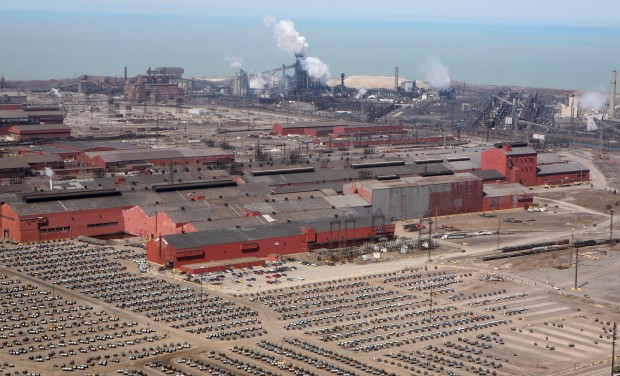That Dude Who Voted No On My Zoning Proposal Is Now In Jail And Schadenfreude Is Real
In a scenario worthy of the Duma or a small, post-colonial African republic, newly reëlected East Chicago city councilman Robert Battle, who once shot down a zoning proposal I had to create six market rate rentals in a disinvested block in the middle of town, took the oath of office from a jail cell in Porter County, Indiana last week.
I couldn’t make this up. And the Hoosier State is oddly cool with it:
“Indiana law permits Battle to hold his seat – and collect the $42,365 salary that it pays – until he resigns, admits his guilt on any of the charges or is found guilty in court. Battle, a Democrat, ran unopposed in November and received 308 votes.”
So, a whopping 1% of the 29,968 residents in East Chicago, voted to keep the dude in office even after his arrest last September— well in advance of the November election.
Now, I would not grant Mr. Battle the distinction of being an honorable sort of hustler, but East Chicago has a rich history of flaunting the law going back to Prohibition, when its mayor and chief of police were forced to resign after being caught dealing in bootleg liquor. Former Mayor George Pabey was in 2011 sentenced to five years in jail for fraud and conspiracy, pilfering funds while the city was in fiscal freefall. (I would like to think they have taken a leaf out of Illinois’ book, though they are in the law-abiding state of Indiana).
So how did I fall victim to this same trend of municipal dysfunction?
For the sake of story, let’s go way back, for the sake of some historical understanding here:
I was, for a time, co-owner of a building in the funny little industrial city sandwiched between Hammond and something (Gary, maybe, but no one is really sure– the industrial and periurban landscape betrays sensibilities of centeredness or place). For anyone unfamiliar with the town (and that’s most of you), it tells a story similar to other my other Rust Belt favorites of the almost identically-sized city of McKeesport (1930-1960 decennial populations hovered around the mid 50’s) or Gary.
Forget the history of municipal dysfunction– the city has a rich history of industry– something often missed in our quests to quickly get through the place on Cline Avenue while escaping a traffic jam on the Borman Expressway. Built around the Indiana Harbor, essentially an entire city of steel mills located right on Lake Michigan, today joining peer industrial behemoths like BP’s Whiting Refinery, US Steel’s Gary Works, and, formerly, Chicago’s South Shore Works, East Chicago was at one time called the “Twin City,” defined by an East Side (East Works, 1901) and a West Side (West Works, 1923, Youngstown Sheet and Tube).
Inland Steel stopped being a thing in 1998 and ended up being acquired by Ispat, later Mittal, later, ArcelorMittal which, along with US Steel, continue to profitably operate plants in the Harbor. Arcelor actually won some awards for installing a gas capture system at the giant blast furnace that is still in operation—to give you an idea of how giant the operation is, a steam turbine burning a portion of the 22% of the gas from the furnace that isn’t already recaptured would create enough electricity to power 30,000 homes, or, the entire city of East Chicago. That’s pretty sweet.

So, though perhaps forgotten in the collective consciousness of much of Chicago proper, Indiana Harbor still hosts a handful of huge employers and is probably the largest single-use (industrial) district in these United States (the aforementioned blast furnace remains the largest in the US). The working class city itself, with a poverty rate over 20%, is racially diverse, almost equal thirds white, black, and Latino. It also is home to the Marktown Historic District, which is surrounded entirely by the expansive BP Whiting Refinery and steel mill facilities, the former of which continues to jockey to acquire the remaining occupied houses and demolish them to build… more refinery?
Back to 2013: At various points I have made references to changing out of work boots into dress shoes. I did this for the first time when I went from supervising renovations of a few homes on Gary’s east side to the East Chicago Board of Zoning Appeals. I got some odd looks from passersby, changing in the parking lot to avoid being spotted by the Board—but made it to the meeting on time.
Handbuilt had with its private equity partners bought the largely intact, eight-unit building and had a budget to downsize it into six units so that two units could be larger and there could be a common area for storage.
Problem is, East Chicago’s patchwork of R1 and R1a zoning, which would have allowed, through grandfathering, the higher density, required a variance because the building had been vacant. I deduced, based on the fact that few of the zoning maps indicated higher density in the city’s majority single-family housing landscape, that
Piece of cake, though, I thought—the only tenant creating any traffic on that corner was a Church of God In Christ, and the rest of the area was single family houses.
I spent $600 to serve notice of the zoning appeal to residents within a stone’s throw per the city requirements. I came armed with drawings, courtesy of the talented designer and urbanist Sam Wesselman, who was at that point interning with Handbuilt working on our law-related services. The drawings, neatly packaged in a several-page booklet, talked up the high-efficiency furnaces, double-glazed windows, insulation retrofit, the clever, modern kitchens, this many jobs created, blah blah blah.
I did a traffic study and tracked the number of parking spaces available during the workday and in the evening. I mapped it over time, and I measured everything on Google to make sure I was adhering to best practices for parking planning.
It was a slaughter. Not much of a Battle, certainly. I was one of two applicants, the other of which was a local entrepreneur who had bought a very similar mixed-use building about a block away from mine and was applying for a variance that would let him open a barbershop in the first floor space.
I presented, and the hearing went something like this:
“What about parking?”
“What about parking?” I asked.
“There’s a church across the street. Parishioners are going to have a hard time finding parking if you have six new apartments where everyone has their own car. You might have an additional ten or twenty cars on that corner.”
(Ten or twenty cars– for six apartments?)
An older Mexican man who spoke timidly through an interpreter about concerns over parking looked as though maybe one of the councilmen had come to his house and threatened to write him a ticket for an invented infraction if he didn’t come to help drive a nail in the coffin of these two proposals.
Okay, so, parking.
“What about trash?”
“Well, there is going to be a dumpster out back, here, which would be provided by us, per the city’s regulations for multi-family buildings…”
“Yes, but these are renters. Who is to say that they’re going to take care of their trash?”
“Sir, I’m a renter—I take out the trash myself and put it in the bin.”
The barbershop did not fare better. The owner came with his attorney, a slick but well-dressed young man. The man presented about realizing his dream– to cut hair and activate a vacant community space. But there were questions. The barbershop might bring in riffraff, one councilperson expressed. My favorite response was one that indicated the profound entrenchedness that seemed to summarize my experience:
“I been knowing Chris since forever,” a councilwoman said, “so it’s just really a shame that we have no choice but to deny his petition.”
Essentially, she was saying, no matter how “in” one got with the powers that be, there was no fighting inevitability. Nothing could change. I tried to make the case for renovating a vacant building that had been derelict for years, the site of illegal dumping and unsavory activity.
“It’s a shame, but this city was built when we needed different things,” chairman Lenny Franciski of the 2nd District had told me, self-assuredly, launching into an explanation of how these homeowners worked hard so they could own their own home, and they didn’t want renters (“those people”) on the block. “You know, it might have worked for an eight unit building to be there back in the day, but that’s just not what we want in our city now.”
I had the audacity to ask him what they wanted there instead.
“Well, the city could demolish it.”
At public expense. Good night.
Unanimous no vote, and Mr. Battle grinned dimly.
Well, whatever– that guy’s in jail now.
As I was leaving the meeting, understandably bummed out, an older, bespectacled black man in a USW jacket put his hand on my shoulder and said, “Welcome to East Chicago, buddy. Sorry it didn’t work out for you.” I said thanks. “I guess you’re learning how folks think they have to do business around here,” he said with a grin.
I’m not going to give up working in challenging municipalities like this, because they all have value, and a lot of that value involves recognizing a careful balance of the value of their history, their human capital and social capital, and their affordability for new development. But I will say this: There are reasons why some distressed municipalities figure out solutions and other ones don’t.




